Explore 13 unique animals in Prescott National Forest on our hiking adventures! Dive into captivating encounters, trail insights, and tips for wildlife spotting.
Step into the enchanting Prescott National Forest and prepare for a thrilling journey through nature’s wonders. With the fragrance of pine in the air and the cool, earthy ground beneath your hiking boots, every step is a promise of discovery.
Here, the wilderness comes alive, offering a vibrant tapestry of animal encounters that range from the majestic black bear foraging in the distance to the distinctive call of the Gambel’s Quail.
This is not just a walk; it’s an intimate dance with the wild, a series of unexpected moments and awe-inspiring sightings. We’ve been fortunate enough to witness 13 unique animals on our excursions, each contributing to the rich narrative of this beautiful habitat.
Ready for a captivating adventure? Lace up those boots and join us as we delve deep into the heart of Prescott National Forest, uncovering the stories of its wild inhabitants and exploring the trails where they roam.
The Wilderness of Prescott National Forest:
Spanning over 1.25 million acres, the Prescott National Forest is a vast expanse of Arizona’s rich biodiversity.
The forest is a mosaic of varied terrains — from rugged granite mountains to dense ponderosa pine forests, punctuated by pristine lakes and rolling meadows.
These diverse landscapes form unique habitats that cater to a wide array of wildlife, each adapted to their specific environment.
The importance of these habitats cannot be overstated. They serve as crucial sanctuaries for the many species that inhabit the area.
For the elusive mountain lion, the dense forests offer cover for hunting.
For the Gambel’s Quail, the meadows provide open grounds to forage. Every tree, stream, and rock formation plays an integral role in the survival of these animals.
Preserving these habitats is imperative. Beyond their immediate aesthetic appeal, they are the backbone of the region’s ecological balance.
As stewards of nature, it’s our responsibility to ensure that the intricate web of life in the Prescott National Forest remains undisturbed and vibrant for generations to come.
Now, we have been going to Prescott for the last 2 decades. The fall is a special time, when temperatures fall and the animals come out!
13 Animals in Prescott National Forest We have Seen on Our Hikes
Coyote
The howl of a coyote is a haunting signature of the Prescott National Forest. These “songdogs,” with their tawny coats and pointed ears, blend seamlessly into the forest underbrush.
We have seen them on the Thumb Butte Trail or the Granite Basin Loop, especially during the soft light of dawn or dusk.
What makes coyotes remarkable is their adaptability. Their diet varies from small mammals to fruits, allowing them to thrive in diverse habitats from dense forests to city outskirts.
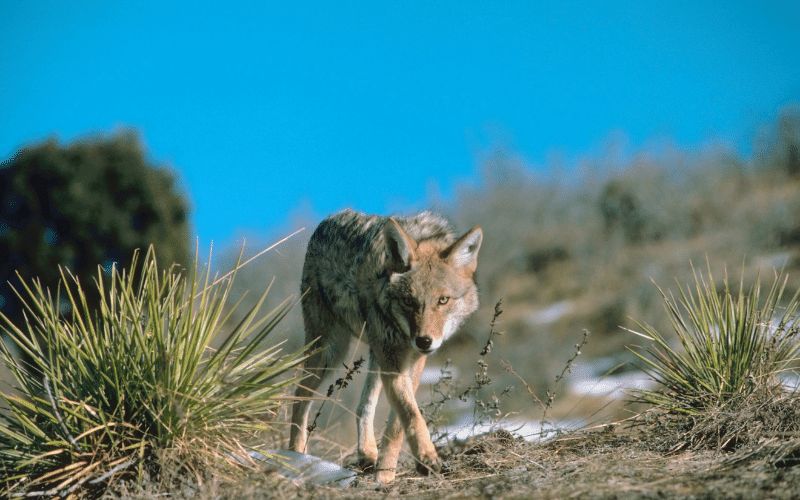
While often perceived as lone wanderers, coyotes can be surprisingly social. They form packs, mainly family units, joining forces in hunting and defending their territories.
This blend of adaptability and community spirit showcases the coyote’s enduring presence in the wild landscapes of America.
Bobcat
In the serene environs of Prescott National Forest, amidst the variety of animals, there’s one that stands out with its striking appearance: the bobcat.
During one of our hikes, we were fortunate to have an unforgettable encounter with this elusive creature, watching it move with a silent grace.
Resembling a house cat, though notably larger, a bobcat’s size is deceptive. Weighing between 15 and 30 pounds, they strike a balance between being compact yet powerful.
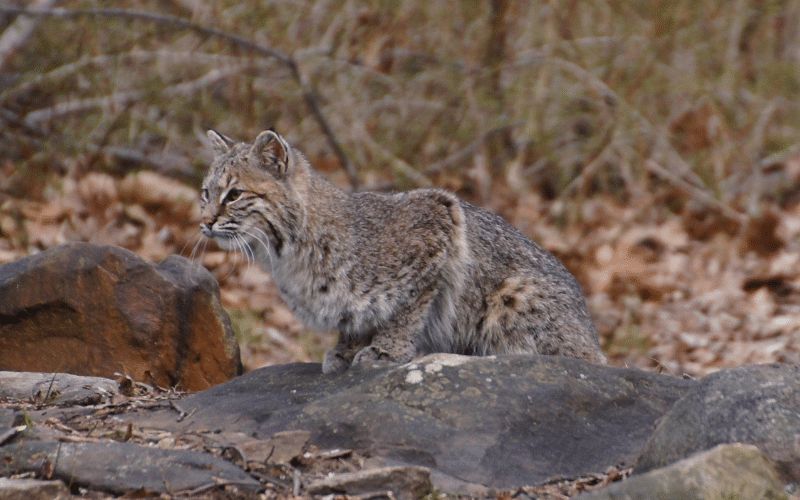
Don’t let their size fool you; these creatures are adept predators, most active during the nocturnal hours, skillfully hunting prey ranging from small mammals to birds.
The bobcat’s beauty lies in its fur – typically a warm tan adorned with black spots and streaks.
However, their coat can subtly change, influenced by their surroundings, allowing them to merge effortlessly into different landscapes.
It’s in the Prescott National Forest that one can witness them in their natural habitat, often camouflaged in the underbrush or agilely scaling trees.
Walking trails like the Granite Mountain Trail or the Lynx Lake Loop increases your odds of spotting a bobcat. If you do come across one, it’s a moment to pause, admire, and respect.
These wild cats epitomize the raw beauty and adaptability of nature, reminding us of the wonders the forest holds.
Black bears
Within the diverse fauna of Prescott National Forest, one might be fortunate to witness the majestic presence of the black bear.
This native species, while appearing calm and often engrossed in their natural routines, is a wild creature that demands our respect and space.
Typically, black bears are creatures of solitude, leaning more towards caution and shyness around humans. Their demeanor shouldn’t be mistaken for tameness.
They’re unpredictable in nature, and even if they seem nonchalant, it’s vital for hikers to exercise caution.
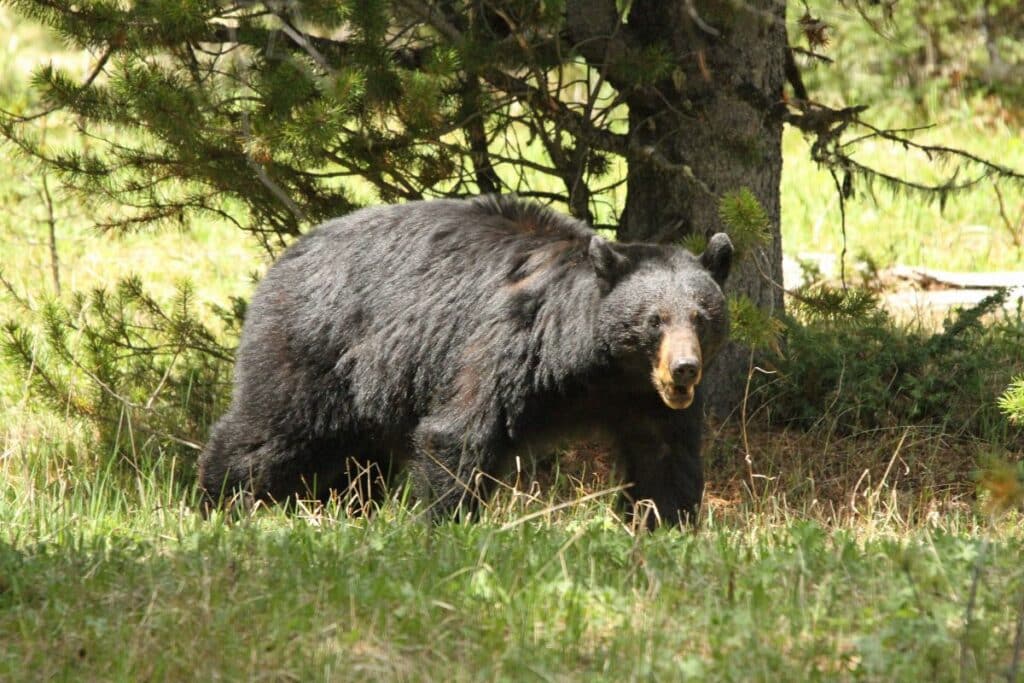
Encounters can happen, especially along trails like the Spruce Mountain Trail or the Watson Lake Trail. If you ever find yourself in close proximity to a black bear, refrain from approaching it.
Your best approach is to appear non-threatening; minimize your size, avoid direct eye contact, and steadily create distance without turning your back.
A calm bear might be indifferent to your presence, letting you continue your hike. Yet, if you notice signs of distress or agitation – ears pulled back, huffing, stomping, or a direct charge – it’s an unmistakable cue to retreat and give the bear ample space.
Always prioritize safety, respecting the bear’s territory, and the wild unpredictability that the forest brings.
Mule deer
Amidst the green expanse and winding trails of Prescott National Forest, mule deer are a familiar and enchanting sight.
Their name, inspired by their large, mule-like ears, paints only a fragment of their charm. Often, as the sun pierces through the tall trees, you might catch them gracefully grazing by the trail or making their way through open meadows, their movements echoing the forest’s calm rhythm.
Unlike some forest inhabitants that prefer the cover of night, mule deer are diurnal, active and visible during daylight hours.
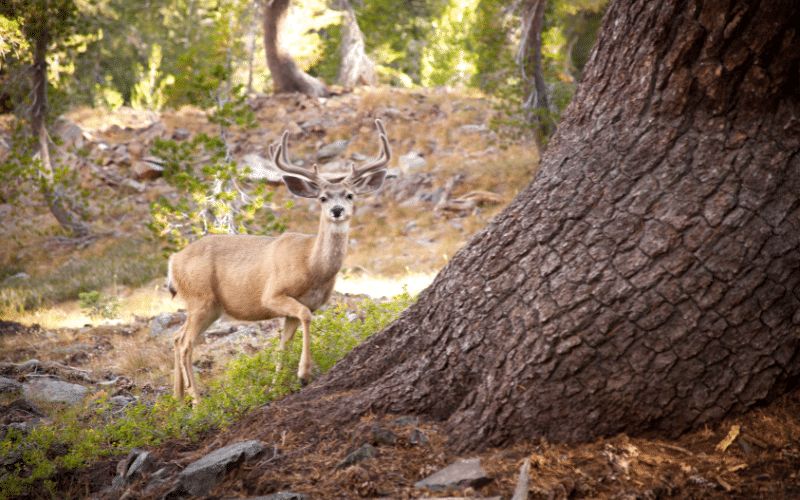
Their diet is predominantly herbivorous, feasting on an array of grasses, shrubs, and other vegetative delights that the forest generously offers.
This makes spots like the Aspen Trail or the Goldwater Lake Trail perfect places to potentially observe these gentle creatures, as these trails meander through their preferred habitats.
As seasons shift and winter blankets Prescott in a layer of snow, mule deer exhibit a remarkable adaptability.
To counter the challenges of deep snow and scarcity of food, they migrate, seeking areas with lesser snow cover and more abundant nourishment.
Their presence and behavior are a testament to the forest’s ever-changing dynamics and the intricate balance of nature.
Elk
Amid the captivating landscapes of Prescott National Forest, encountering an elk can be one of the most breathtaking moments.
Their grandeur is evident, not just in size, but in their very demeanor. As the largest members of the deer family, some elk can weigh up to an astounding 1,000 pounds, their splendid antlers reaching skyward in a display of nature’s artwork.
These creatures have a particular fondness for the quietude of early mornings and the serene dusks. Yet, it’s not uncommon to find them grazing peacefully in the forest’s clearings throughout the day.
Trails such as the Lynx Lake Loop or the Willow Lake Trail offer hikers a good chance to marvel at these beauties from a distance.
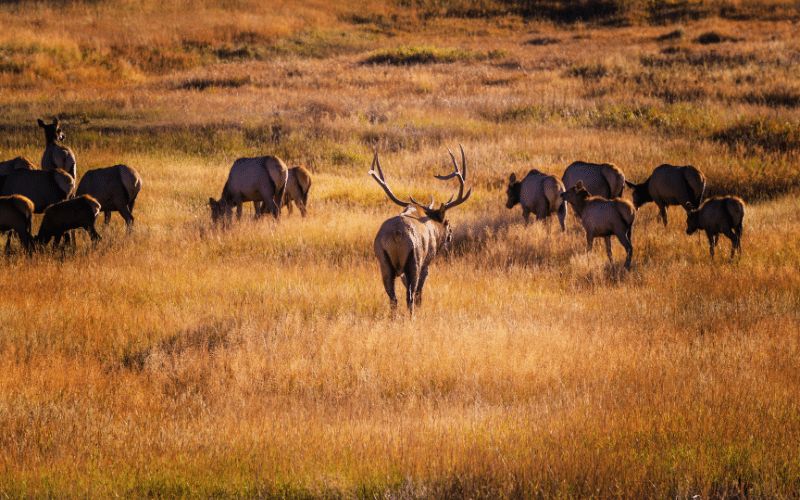
While their majesty is undeniably awe-inspiring, what’s equally fascinating is their unique role in the ecosystem of Prescott. Elk herds have been instrumental in shaping the vegetation patterns of the region.
Their migratory patterns, often influenced by seasonal changes, are a sight to behold, as they move in search of fresh pastures and water sources.
Moreover, the elk’s vocalizations, particularly during the rutting season, echo through the forest in hauntingly beautiful calls, a testament to the wild, unspoiled heart of Prescott National Forest.
Javelina
On one of our treks through Prescott National Forest, we chanced upon the unique and ruggedly charming javelina.
Native to the southwestern US, this member of the pig family seems perfectly at home amidst Prescott’s varied landscapes.
Distinguished by a dark coat with a contrasting white stripe down their back, these creatures, weighing in between 20-40 pounds, meander the trails and clearings, often foraging.
Their diverse diet speaks volumes of Prescott’s rich biodiversity – from fruits to insects and even the occasional lizard.
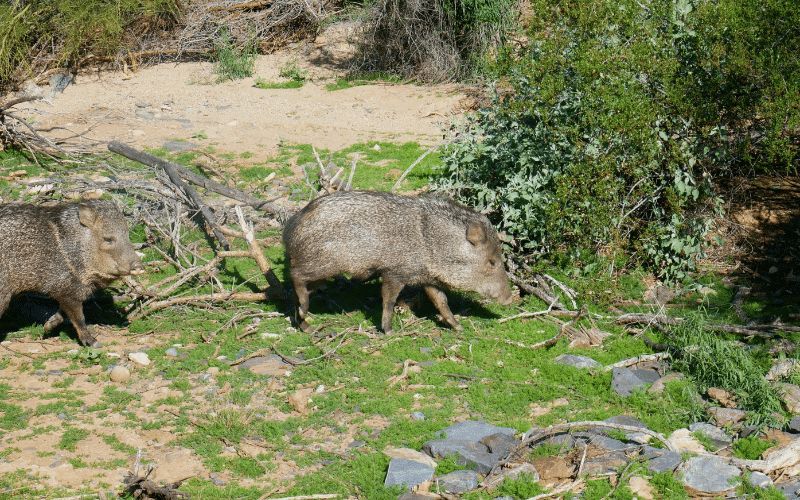
While it’s tempting to get a closer look, especially when you’re in the habitat-rich zones like the Granite Basin Loop or Peavine Trail, it’s always best to admire javelinas from a safe distance.
Their presence, along with other wildlife, adds to the magic and unpredictability of hiking in Prescott National Forest.
Mountain lion
Hiking through the Prescott National Forest, every rustle and distant sound is a hint of the vibrant life that calls this wilderness home. One of the most elusive and awe-inspiring residents is the mountain lion.
Often known as the ghost of the forest, this magnificent predator moves with a stealth and grace that belies its power.
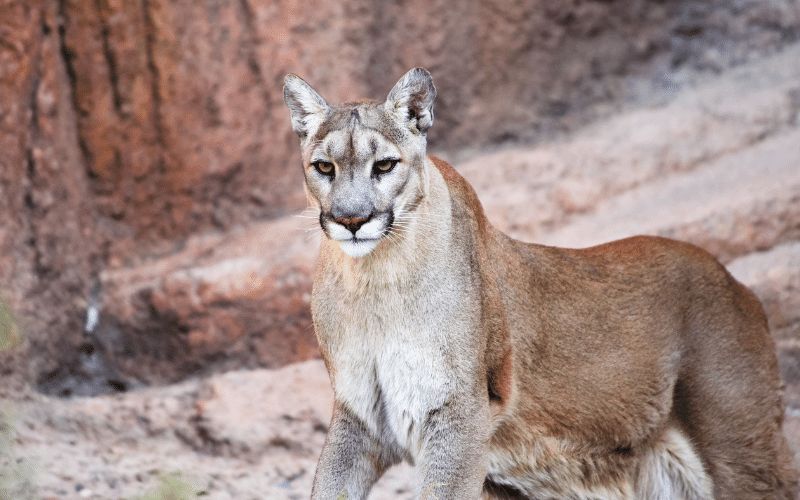
Mountain lions, also known as cougars or pumas, are apex predators with a territory that can span vast stretches of land. Their tawny coats blend seamlessly with the forest’s backdrop, making them incredibly adept hunters.
With an impressive leap and agility, they’re known to hunt everything from deer to smaller mammals.
In the expanse of Prescott National Forest, spotting a mountain lion is rare, and if you do, it’s usually a fleeting glimpse along trails like the Spruce Mountain Trail or the more remote stretches of the Aspen Trail.
While their presence might be felt more than seen, evidence of their habitation like paw prints or distant calls can sometimes be observed.
It’s essential to remember the wild nature of the mountain lion when hiking in Prescott. They are wild creatures, commanding respect and space.
But just knowing that such a majestic animal shares the trails with you adds an exhilarating touch to every hike in the forest.
Squirrels
Wandering through the diverse terrains of Prescott National Forest, amidst the towering trees and rustling leaves, there’s a playful presence that often catches one’s attention – the squirrels.
These nimble creatures, with their twitching tails and alert eyes, add a lively touch to the forest ambiance.
Unlike some of the forest’s more elusive inhabitants, squirrels are often seen darting up tree trunks, scampering along the forest floor, or cheekily foraging for nuts and seeds.
Their energy is infectious, making even a simple walk along the Goldwater Lake Trail or the Granite Mountain Trail a delightful game of ‘spot the squirrel’.
In the context of Prescott’s diverse ecosystem, squirrels play a vital role. They are nature’s gardeners.
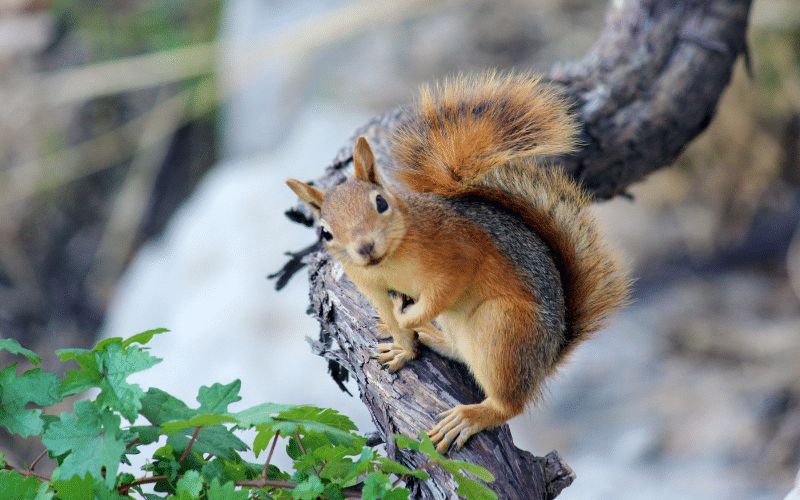
As they bury their stash of acorns and seeds, they inadvertently aid in the germination of new plants, ensuring the forest’s continual growth.
Furthermore, their keen sense of hearing and sharp eyesight often make them the forest’s early warning system, alerting fellow woodland creatures of approaching dangers.
So, while they may seem like just cute, furry entertainers, squirrels are a testament to the interconnectedness of life in Prescott National Forest. Their presence underscores the harmony and balance of this beautiful natural haven.
Chipmunks
Amidst the expansive beauty of Prescott National Forest, it’s often the tiny, bustling chipmunks that catch a hiker’s eye.
With their distinctive striped backs, they dash across trails and perch on rocks, adding a playful element to the forest’s tapestry.
On trails like Lynx Lake Loop or Watson Lake Trail, these little adventurers can be spotted collecting and stashing food, ever preparing for changing seasons.
Beyond being forest foragers, chipmunks play an ecological role, aiding in the propagation of many plant species as they bury seeds.
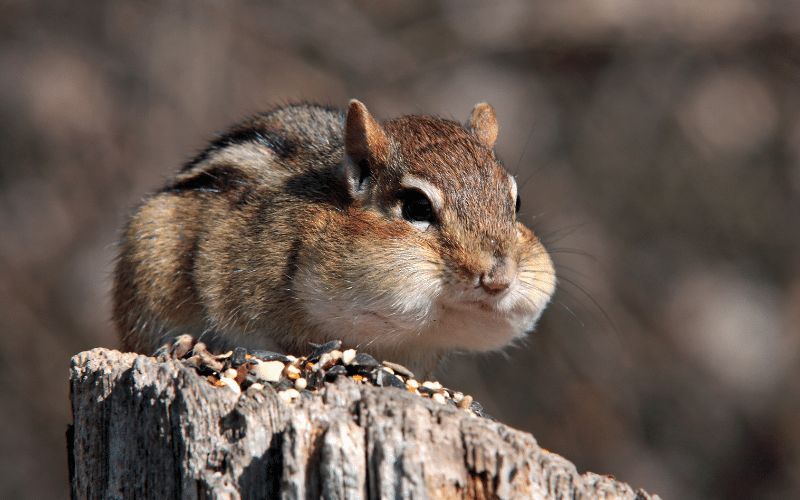
As hikers immerse themselves in Prescott’s majestic landscapes, the spirited chipmunks stand as delightful reminders that even in vast wilderness, the smallest wonders can leave a lasting impression.
Downy Woodpecker
As you traverse the diverse trails of Prescott National Forest, the rhythmic drumming of the Downy Woodpecker often punctuates the ambient forest sounds.
This small woodpecker, with its iconic black and white plumage and a hint of red on the males, is a delight for both avid birdwatchers and casual hikers.
Often seen on the likes of Willow Lake Trail or Aspen Trail, the Downy Woodpecker can be found tapping away at tree barks, searching for insects, their primary diet.
Their ability to cling to tree trunks and branches, moving with agility, is a captivating sight against the forest’s lush backdrop.

In the broader context of Prescott’s ecosystem, the Downy Woodpecker plays a vital role. By feasting on insects that can be harmful to trees, they act as natural pest controllers, ensuring the health of the forest’s vegetation.
So, the next time you’re enveloped by the serene beauty of Prescott National Forest, pause and listen for the telltale taps of the Downy Woodpecker.
This diminutive bird, with its outsized presence, beautifully encapsulates the interconnected vibrancy of life in the forest.
Gambel’s Quail
Walking through the Prescott National Forest, the sudden burst of rapid wingbeats or the melodic calls of the Gambel’s Quail might surprise and delight you.
These ground-dwelling birds, easily identified by their topknot feathers and beautiful patterning, bring a unique vibrancy to the forest’s vast terrains.
On trails such as the Granite Basin Loop or Peavine Trail, hikers might be treated to the sight of these quails scuttling through underbrush or leading a line of their chicks in tow.
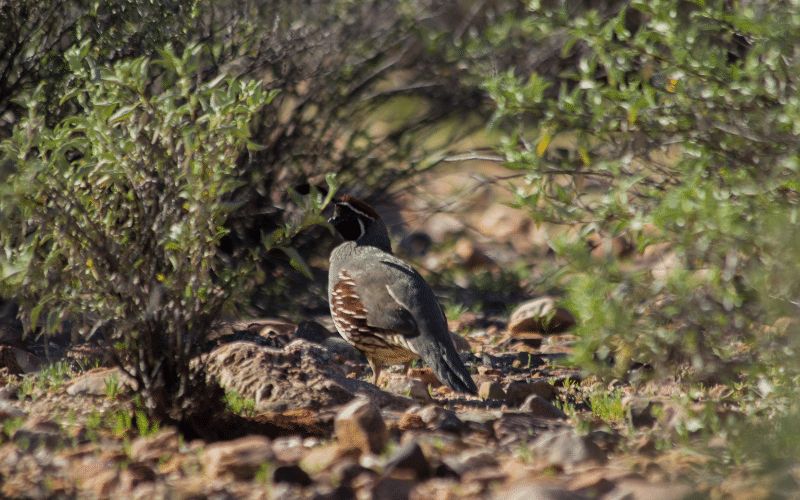
These birds have a preference for scrubby landscapes, making the diverse vegetation of Prescott their perfect haven.
Gambel’s Quail, while often seen on the ground, are also great foragers, feeding on a variety of seeds, leaves, and occasionally insects.
In the Prescott ecosystem, their diet plays a subtle role in seed dispersal, contributing to the forest’s continual regeneration.
As the sun begins to set over the Prescott National Forest, the echoing calls of the Gambel’s Quail serve as a gentle reminder of the many layers of life that thrive in this stunning natural retreat.
Every encounter with them is a testament to the region’s rich biodiversity and the wonders waiting to be discovered.
Bald Eagles
The expansive skies of Prescott National Forest often host the majestic flight of the Bald Eagles. This iconic bird, known for its white head and formidable wingspan, is a symbol of strength and freedom.
As you hike trails close to bodies of water, like Watson Lake Trail or Willow Lake Trail, keep an eye to the sky or on the treetops. Bald Eagles often perch high, scouting for their next meal.
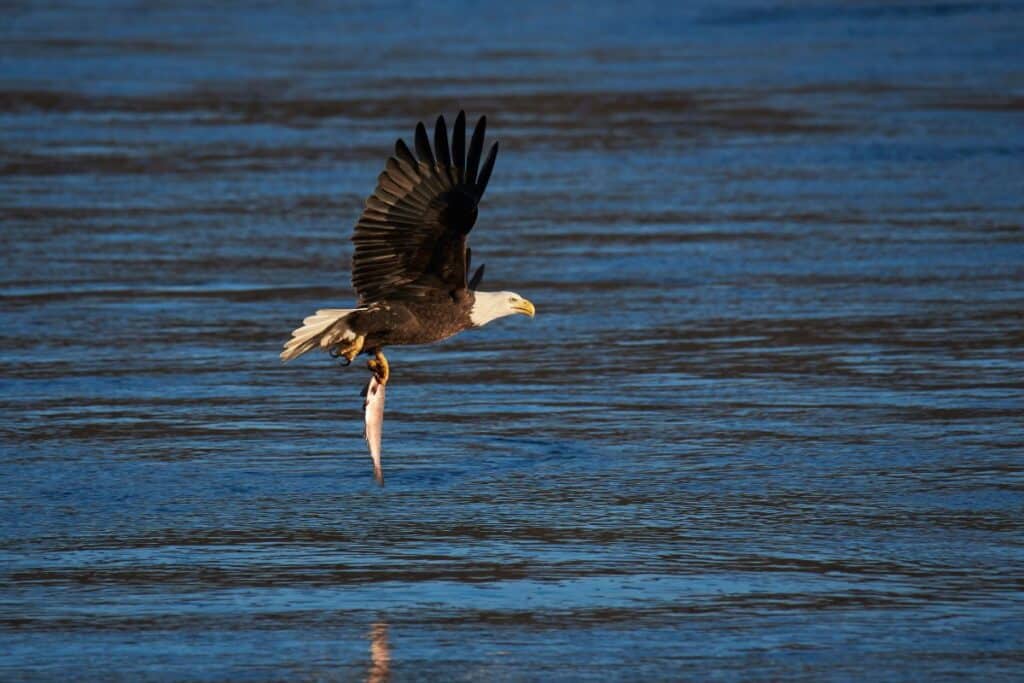
While the forest offers a variety of prey, Bald Eagles in Prescott predominantly focus on fish. This makes the areas around lakes and rivers prime spotting locations.
The sight of a Bald Eagle diving to snatch a fish from water is breathtaking and speaks to the raw beauty of nature in action.
Additionally, the presence of these eagles is an indicator of the health of the forest’s ecosystem. Their high position in the food chain means a stable and thriving environment below.
Raccoons
The playful bandits of the animal kingdom, raccoons, add a touch of mischief to the Prescott National Forest.
Their distinct black-masked faces and curious nature make them a delightful, albeit sometimes elusive, sight for hikers.
During evening hikes, especially around areas like the Spruce Mountain Trail or Lynx Lake Loop, you might spot these nocturnal creatures foraging for a diverse diet ranging from fruits and plants to smaller creatures. Their nimble fingers allow them to explore and manipulate their environment with surprising dexterity.
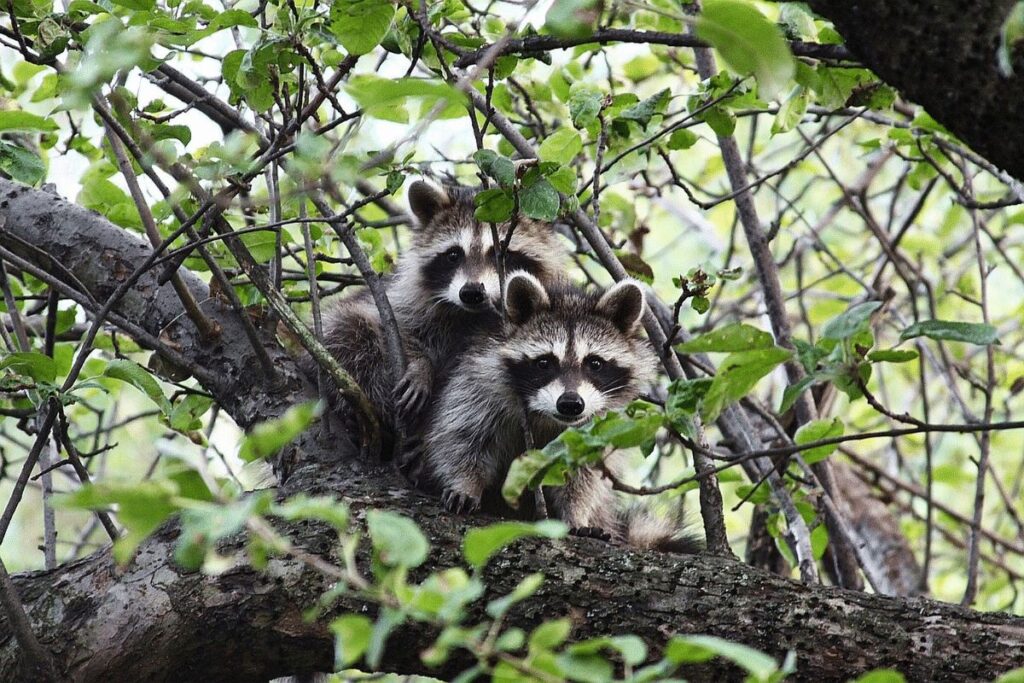
But it’s not just their cute faces that make raccoons interesting. In the ecosystem of Prescott, raccoons play a vital role in controlling pests, helping to maintain a balance in the food web.
Their adaptability to varied habitats and resilience to changing conditions makes them a testament to the dynamic life that thrives in the forest.
Remember, while both these creatures can be a joy to observe, always admire from a distance and respect their natural behaviors.
4 Trails on Which We Saw Wildlife in Prescott National Forest
Prescott National Forest boasts an array of hiking trails, each offering its own unique wildlife encounters.
These trails, ranging in length and difficulty, wind through diverse habitats – from dense forests to open meadows – making them prime spots for animal sightings.
Whether you’re looking for a leisurely hike or a challenging trek, you’re bound to come across some of the forest’s residents.
Here’s a glimpse into some of these trails and the creatures we’ve had the fortune to observe on them.
Thumb Butte Trail
A signature feature near Prescott, the Thumb Butte Trail not only promises hikers an invigorating workout but also a potential rendezvous with the forest’s fascinating wildlife.
Tucked into the backdrop of Prescott, Thumb Butte Trail is an iconic landmark. With an approximately 2-mile loop, this trail is known for its challenging ascent on the west side and a more relaxed descent on the east.
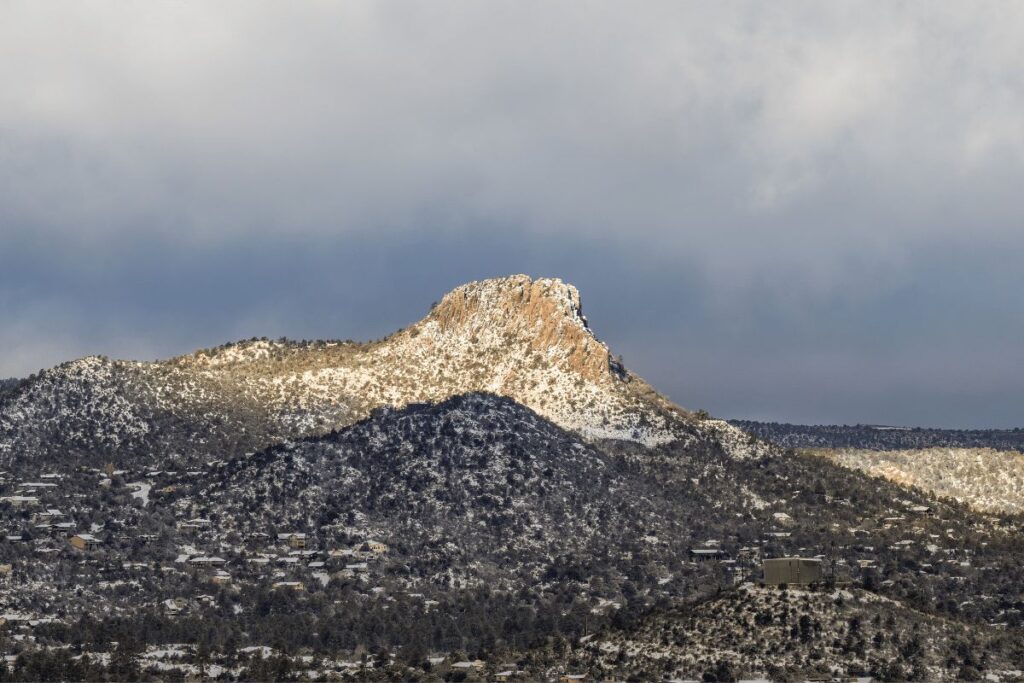
As you approach the top, the viewing platform provides panoramic vistas of the Prescott area and distant mountain ranges. It’s not unusual for hikers to spot mule deer and squirrels here, particularly in the early hours.
Granite Mountain Trail
For those seeking a combination of challenging terrain and a chance to observe Prescott’s varied fauna, Granite Mountain Trail beckons.
Granite Mountain, a monolith in Prescott National Forest, is the centerpiece of this roughly 8-mile round-trip trail.
The trail kicks off at the Playa Picnic Site and offers an ascending hike through pinyon, juniper, and ponderosa pine ecosystems.
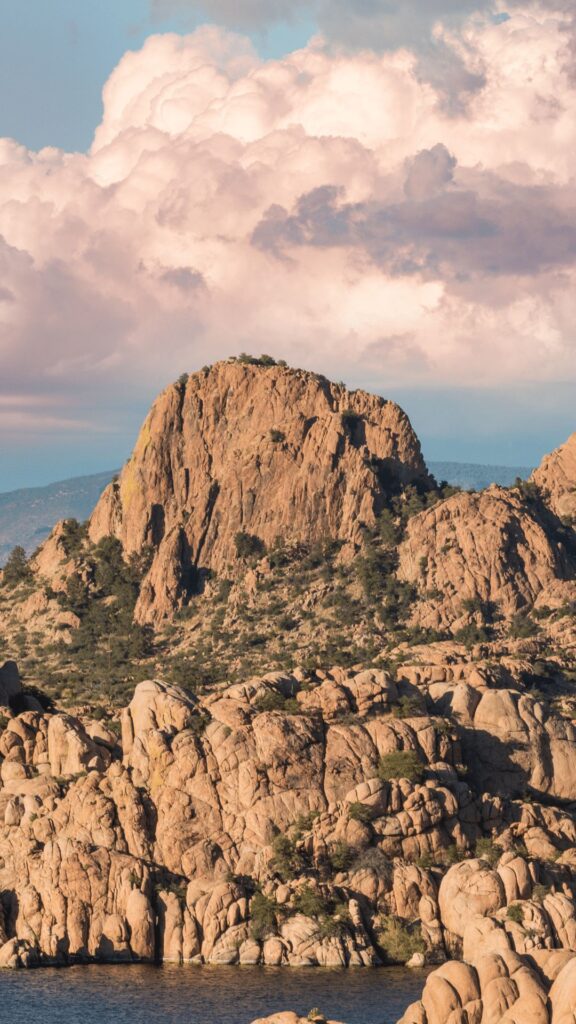
Given its rich biodiversity, sightings of the Gambel’s Quail, and occasionally bobcats, are not uncommon.
The trail promises spectacular views, particularly from the Granite Mountain Saddle, making the strenuous hike worthwhile.
Lynx Lake Loop
A picturesque trail that’s apt for families and casual hikers, Lynx Lake Loop offers a tranquil experience and occasional wildlife sightings.
Covering a gentle 2.3-mile loop, this trail skirts the beautiful Lynx Lake, a popular spot located just a few miles southeast of Prescott.
Beyond the scenic views of the lake, the dense pine forests make for a serene hiking experience.
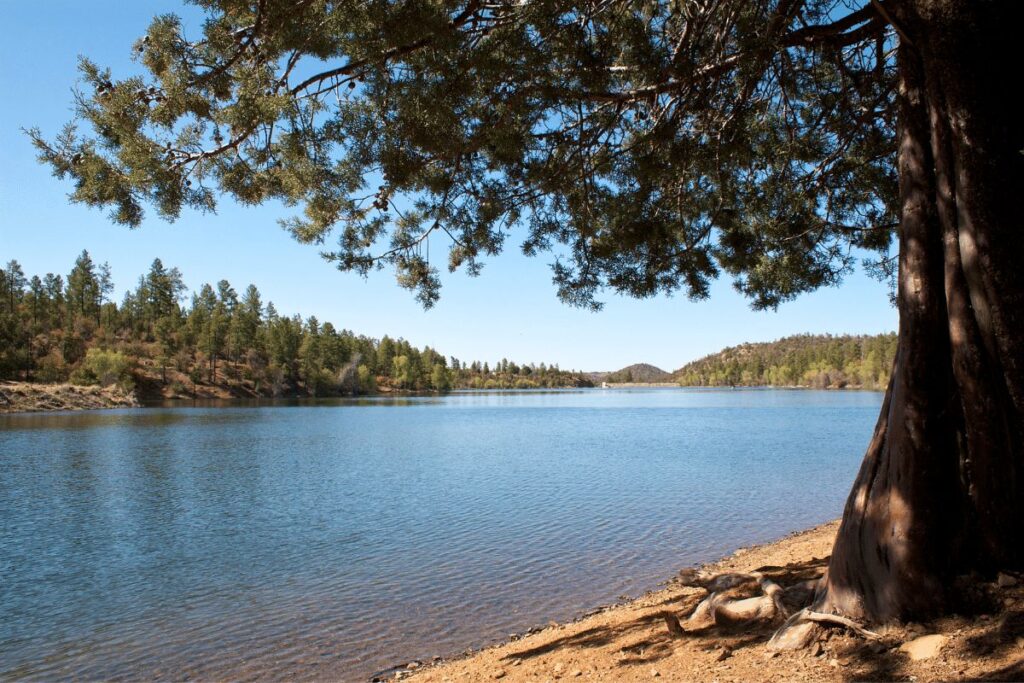
The water’s edge and surrounding woods are often frequented by raccoons, squirrels, and a variety of bird species. It’s an ideal trail for those keen on combining a relaxed hike with birdwatching.
Spruce Mountain Trail
A journey through dense forest canopies and spectacular vistas, Spruce Mountain Trail is for those who seek solitude and a deeper connection with Prescott’s wildlife.
Winding its way through the heart of Prescott National Forest, this trail covers about 6.2 miles round-trip.
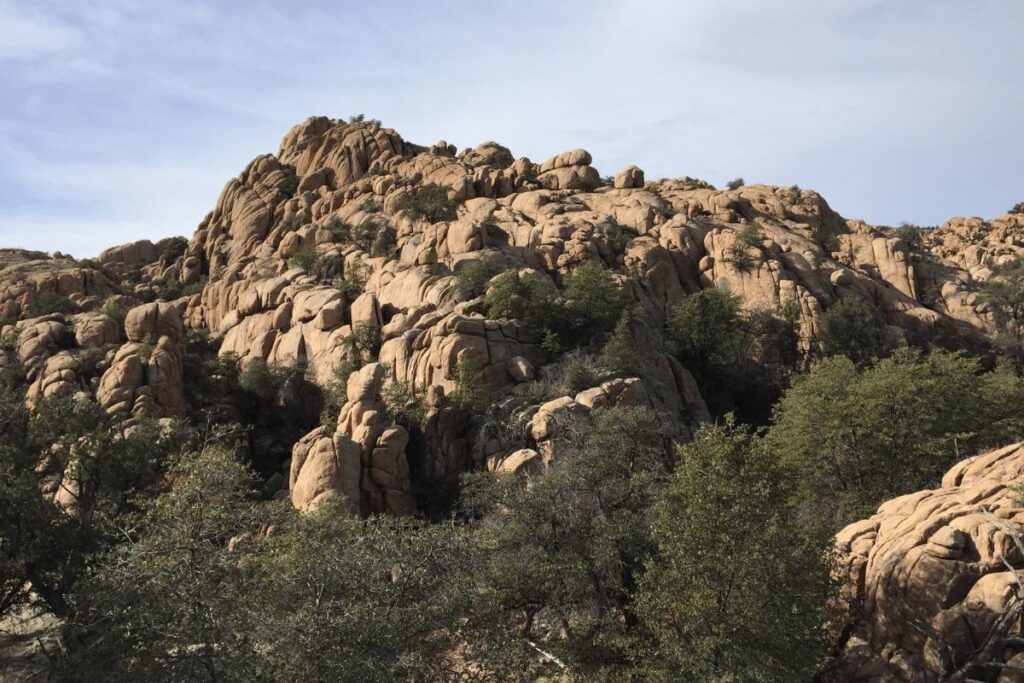
Initiating at the Groom Creek Horse Camp, the trail meanders through dense groves of ponderosa pines and offers a steady climb to the summit. At the top, a fire tower provides panoramic views of the surrounding landscapes.
The shaded path is often a refuge for chipmunks, and the Downy Woodpecker’s distinctive sound frequently resonates through the trees.
We have a more comprehensive guide to hiking in Prescott which goes deeper into each trail.
10 Tips to See Animals in Prescott National Forest
Prescott National Forest in Arizona is a diverse and beautiful area teeming with wildlife. Here are ten tips specifically tailored for wildlife viewing in this forest:
- Best Times: Wildlife is often most active during the early morning and late afternoon. Plan your trips to coincide with these hours to increase your chances of encounters.
- Know the Zones: The Prescott National Forest is divided into different habitats, from grasslands to thick forests. Familiarize yourself with the wildlife native to each zone. For example, deer, javelinas, and wild turkeys tend to roam the ponderosa pine forests, while pronghorns can be found in open grasslands.
- Stay Quiet & Observant: Move slowly and quietly through the forest. Avoid loud noises, and use binoculars to spot animals from a distance.
- Use Wildlife Viewing Areas: The Forest Service sometimes designates specific wildlife viewing areas. These are great places to start, as they often have information about what animals you might see.
- Visit Lynx Lake: This is a popular recreation area within the Prescott National Forest. Around the lake, you might spot waterfowl, bald eagles (especially in winter), and even the occasional osprey.
- Go Birdwatching: The forest is home to many bird species. The Granite Mountain Wilderness area is particularly known for its bird diversity. Bring a bird guide specific to the region and a pair of binoculars.
- Stay on Designated Trails: Not only is this important for your safety and the conservation of the area, but animals are more likely to appear in places where human activity is predictable. Straying from the trail can also disturb nesting sites and habitats.
- Watch for Seasonal Migrations: Many animals have specific patterns based on the season. For instance, mule deer tend to move to higher elevations in the summer and return to lower elevations in the winter. Familiarizing yourself with these patterns can help pinpoint where to look.
- Be Bear Aware: Black bears inhabit Prescott National Forest. While it’s thrilling to see one from a safe distance, it’s crucial to store food properly and understand bear behavior to avoid potentially dangerous encounters.
- Leave No Trace: Always practice Leave No Trace principles. This not only helps preserve the environment, but by not leaving food or trash behind, you avoid attracting and potentially harming wildlife.
Lastly, visiting the local ranger station or visitor center can provide valuable, up-to-date information on wildlife sightings and advice from experts familiar with the area.
Are there bears in Prescott National Forest?
Yes, there are bears in Prescott National Forest. Specifically, the forest is home to the black bear species, which can be found throughout various parts of the area.
Black bears are prevalent in the remote regions of the forest, often residing in dense woodland areas.
However, there have been instances where they’ve been sighted closer to trails and campsites.
Contrary to their name, these bears can range in color from a deep black to cinnamon brown, and even an occasional blonde.
Though primarily shy and reclusive, encounters with humans are not unheard of. It’s essential for visitors to always be bear-aware.
Best practices include safe food storage techniques, giving any spotted bears a wide berth, and educating oneself about bear behavior to minimize potential confrontations.
In the broader ecosystem of the Prescott National Forest, black bears play a pivotal role. As predators and scavengers, they manage the populations of smaller animals and also aid in plant distribution through the seeds present in their droppings.
For those planning to explore the beauty of the Prescott National Forest, it’s always advisable to prioritize the safety of both oneself and the native wildlife.
Are there mountain lions in Prescott?
es, mountain lions, also known as cougars or pumas, are present in Prescott and the surrounding areas, including the Prescott National Forest.
Mountain lions are highly adaptable predators and can thrive in various habitats, from dense forests to mountainous regions.
In Prescott National Forest, these elusive cats are often found in rugged terrains and deep canyons where they can stalk prey and find shelter.
They primarily feed on deer but will also consume smaller mammals, birds, and even insects when the opportunity arises.
Given their stealthy nature, mountain lions are seldom seen, and direct encounters with humans are rare. However, hikers and campers should be aware of their presence and follow safety guidelines.
This includes hiking in groups, keeping children close, and avoiding dawn or dusk hikes when mountain lions are most active.
If encountered, it’s essential to appear larger by raising your arms, maintaining eye contact, and speaking loudly.
While they might inspire a mix of awe and apprehension, mountain lions play a vital role in maintaining the health and balance of the ecosystem by controlling deer populations and other species.
Respecting their territory and understanding their behavior is crucial for ensuring peaceful coexistence in the shared spaces of Prescott and its national forest.
Are there bears at Lynx Lake Prescott AZ?
Yes, Lynx Lake in Prescott, AZ, is an area where black bears have been sighted.
Lynx Lake, nestled within Prescott National Forest, offers a variety of habitats suitable for black bears. The lake’s dense forests, coupled with its abundant water source, provides an environment rich in food opportunities and shelter for these animals.
While the chances of encountering a bear during a casual visit are relatively low, their presence underscores the abundant biodiversity of the region. Black bears, primarily omnivores, can often be found foraging for berries, nuts, and small mammals in forested areas, especially during the early morning or evening.
For those keen on observing wildlife, the areas around Lynx Lake present an excellent opportunity. Birdwatching is particularly popular here, but with a bit of luck and a keen eye, one might spot a black bear going about its daily routines, a testament to the thriving natural environment of Prescott.
Do elk live in Prescott AZ?
Yes, elk do live in Prescott, AZ.
Elk are residents of the larger region, including parts of the Prescott National Forest. This expansive forested area provides a suitable habitat for elk, offering ample food sources and vast territories for these majestic creatures to roam.
Prescott’s combination of meadows, forests, and water sources creates an environment conducive to supporting a variety of wildlife, including elk.
Within Prescott, especially in areas bordering the national forest, it’s not uncommon for residents and visitors to catch a glimpse of elk, particularly during dawn and dusk when they are most active.
These graceful animals can often be seen grazing in meadows, or traveling in small groups.
While elk sightings can be a thrilling experience for wildlife enthusiasts, it’s always essential to view these creatures from a distance and not disrupt their natural behavior.
Are there wolves in Prescott?
No, wild wolves are not commonly found in Prescott. While Arizona has been involved in Mexican gray wolf reintroduction efforts, those have primarily been focused in the eastern part of the state, especially in the Apache-Sitgreaves National Forests.
However, it’s always possible for a lone wolf to wander into different areas, but such occurrences would be rare.
What is Prescott AZ known for?
Prescott, AZ, is known for several things. It’s often referred to as “Everybody’s Hometown” because of its welcoming, small-town charm.
Historically, it served as the capital of the Arizona Territory. Today, it’s renowned for its historic downtown area, including Whiskey Row, which boasts a series of old saloons and establishments.
Prescott is also known for its outdoor recreational opportunities with numerous lakes, hiking trails, and being surrounded by the Prescott National Forest.
Additionally, the city hosts events like the World’s Oldest Rodeo and the annual Christmas lighting at Courthouse Square, making it a cultural hub in the region.
Are there foxes in Prescott AZ?
Yes, foxes can be found in Prescott, AZ. The region’s natural habitat, characterized by forests and open spaces, provides an ideal environment for several fox species, including the gray fox and red fox.
These nocturnal creatures are often elusive, but it’s possible for residents or visitors to spot one, especially during dawn or dusk when they’re most active.
Final Thoughts
Prescott National Forest and the broader region of Prescott, AZ, serve as a magnificent testament to nature’s splendor. From the gentle grazers like mule deer and elk to the elusive predators like mountain lions and bobcats, the area is a rich tapestry of biodiversity.
As we trek through the intertwining trails, each corner turned can lead to a chance encounter with wildlife, a moment where nature and humanity observe one another with mutual respect.
Such experiences remind us of the delicate balance in which our ecosystems hang and the significance of preserving these natural sanctuaries.
Whether you’re a resident or a visitor, every journey into the forest offers a renewed appreciation for our environment and the creatures that call it home.
As we wrap up our guide on the wildlife and wonders of Prescott, we hope it inspires you to explore, observe, and cherish these wild spaces. After all, in the dance of nature, every step and every creature plays a vital role.
Safe travels, and may your adventures in Prescott be filled with awe-inspiring moments.

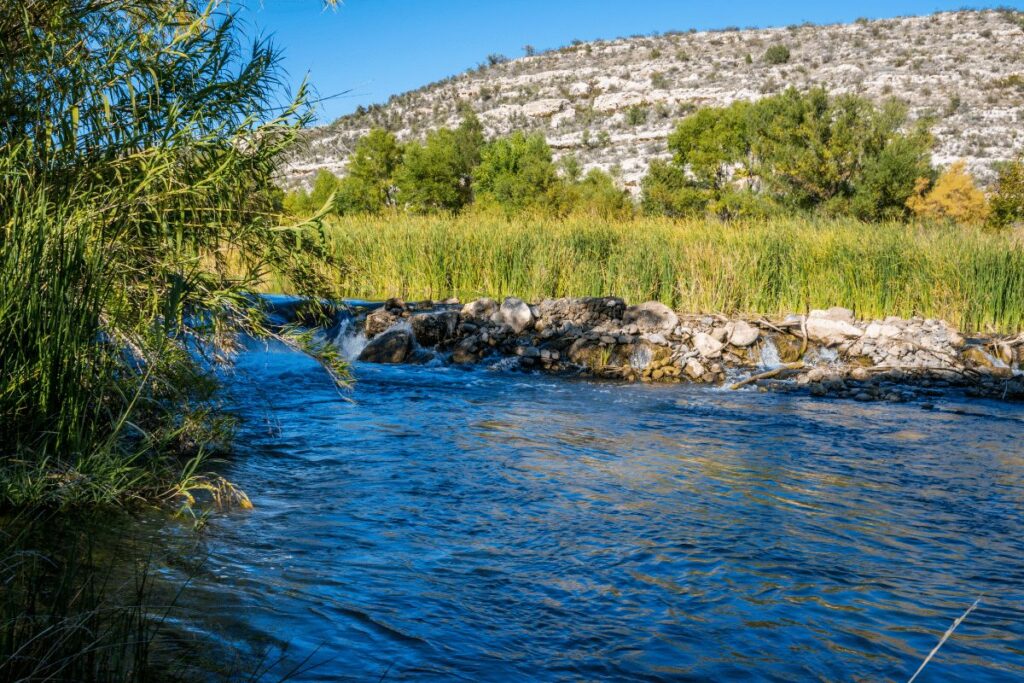
Great concise article. I am looking to come out to Prescott mid April 2024 and will only be there for 2 days so want to maximize my time and chances hiking to view wildlife such as bobcat, mountain lion, elk, pronghorn, or javelina. I have only seen elk in the past and have seen hundreds of bears where I live in PA. This article gives me a little more insight on what trails I may seek to hike. Thank you for publishing.